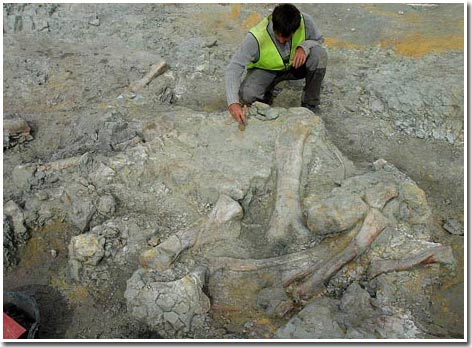Finding dinosaur 'graveyards' in Spain
Archaeologists have discovered a ' graveyard ' containing thousands of dinosaur fossils in eastern Spain.
The number of fossils is relatively large, up to 8,000 samples of 8 dinosaurs, including the world's largest scaly herbivorous dinosaurs. This ' graveyard ' was discovered in June during the construction of a high-speed train line near the city of Cuenca. This is considered the largest and most diverse relic of dinosaurs ever excavated in Europe.
According to paleontologist José Luis Sanz of Autonomous University of Madrid, chief archaeologist, fossils with a life span of about 70 million years reveal the diversity of dinosaurs living in a less studied period. in Western Europe. José believes that studying these fossils will add information about dinosaur diversity.
These fossils appeared about 4 million years before the dinosaurs became extinct. Scientists say it will uncover information about the final dinosaur ecosystem in Europe.
Lo Hueco, the name of the archaeological site, shows that a herbivorous dinosaur is a major resident of this period, including the long-necked Titanosaurs, one of the largest creatures ever to live on. Earth. ' Titanosaurs ' fossil accounts for most of the excavated specimens in Lo Hueco ', Sanz said. Scientists have now identified three Titanosaur species, including those not yet known.
Unearthed fossil samples include limb bones, skull bones and somewhat intact bones. A large number of horn samples show that Titanosaur dinosaurs have quite thick scales. Fossils of two carnivorous dinosaurs were also discovered, one of which is the Dromaeosaur, a fast and aggressive carnivorous dinosaur, about 1.8 meters long.

Fossils from the mass grave of dinosaurs discovered in eastern Spain.(Photo: National Geographic)
Some fossils are of Rhabdodon - a small-bodied dinosaur with blunt teeth to crush plants. Others are of an alkylosaur, a large herbivorous dinosaur with a large tail bone used to fight off attackers. The archaeological team also found fossils of prehistoric turtles and crocodiles.
These fossils are linked by clay and mud, a sign of a river. Sanz said: ' It is possible that a flood causes these organisms to die mass '. This area will provide more information about dinosaur decomposition 66 million years ago.
Many scientists believe that the extinction of dinosaurs in the Cretaceous (Tertiary) event begins with their biological diversity diminishing and eventually disappearing completely by a giant meteorite. Earth.
This newly discovered fossil denied this hypothesis.The entire archaeological area shows that dinosaurs are still very diverse throughout the biological crisis of the KT period . However, this is not really the last remaining dinosaurs in Europe because this fossil appeared before the extinction of the dinosaurs to 4 million years.
Darren Naish, a paleontologist at the University of Portsmouth, UK, said the finding reinforces a recent discovery that dinosaurs are still diverse in Europe before they become extinct. Darren adds that the group of dinosaurs has the same space and habitat, a hypothesis that scientists have never set.
Naish also said that the dinosaurs found in Lo Hueco are relatively common and these fossil samples will help the knowledge of these species to complete.'What is particularly interesting is that this Titanosaur's skull is still quite intact, a rare case because its skull is quite weak and fragile. There is still a lot of controversy surrounding the first shape of this species, especially the European species. '
Fossil specimens also reveal more about Titanosaur's armor: 'We still wonder about the layout of this species' scales. For example, it can be scattered in the back or lined up. '
Fossil specimens located in the highway have been relocated. Excavations will continue to be conducted early next year. Many smaller fossils such as grass, fish scales, freshwater mussels and bits of teeth were also brought to the lab.
- Discover the largest dinosaur cemetery in the world
- Detecting insane mad graveyards
- Discovered several hundred dinosaur eggs in Europe
- Finding tiny dinosaurs in Germany
- Discover dinosaurs 'armored' never known
- Detecting dinosaur eggs in India
- Detection of giant dinosaur fossils in Spain
- Dinosaurs have 'relatives' with modern birds
- Discovered humped dinosaurs like camels in Spain
- Discover embryos in eggs, dinosaurs are revived?
- Shocking discovery of dinosaurs drive and
- Scientists recreate dinosaur embryos from chicken DNA
 Discovered an ancient centipede fossil 99 million years old
Discovered an ancient centipede fossil 99 million years old Discovered bat-like dinosaurs in China
Discovered bat-like dinosaurs in China Discovered a 200-year-old bronze cannon of the coast
Discovered a 200-year-old bronze cannon of the coast Discover 305 million-year-old spider fossils
Discover 305 million-year-old spider fossils